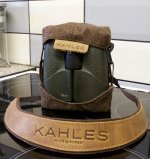has530
Well-known member
All optics involve compromises be it larger dimensions for lower chromatic abberation, lighter weight for a dimmer image with more difficult eye placement, or even just cost for increased quality. As a buyer and user of binoculars every individual has their own preferences and priorities as to what I'd acceptable. For example some people don't notice or care about chromatic abberation. I on the other hand am quite sensitive and would much rather carry something longer to reduce that abberation. Some other preferences or lack therof for me include:
- I do not care about field flatness (to a degree) I like a wide field but I don't need edge to edge sharpness as i am only looking in the middle and just move the binoculars to center my target if I notice something on the edge
- I do not care about exit pupil size. I regularly use an 8x20 and have no problems with eye placement
- I do care about ease of view ("Einblickverhalten"). Blackouts, eye relief (enough to keep my eyelashes off the lenses), eyecup-face shape compatability. This is a top priority for me.
- I do care about glare. I spend a lot of time by the water looking near the sun at sunset. If a binocular has glare problems it is not very usable most of the time for me
- I don't care about color. I use single coated binoculars for birding every now and then and your eyes get used to a color cast very quickly. If there is enough light I don't care if the image is a little warm










